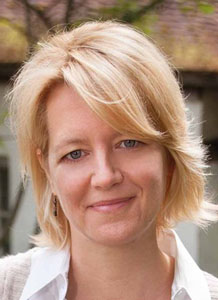
Wendy Lower
Wendy Lower began conducting research at the Shoah Foundation nearly ten years ago. Now, she’s helping bring other scholars to USC for the first-ever USC Shoah Foundation international conference.
Lower is professor of history at Claremont McKenna College, research associate of the Ludwig Maximillians Universitaet in Munich and a historical consultant at the United States Holocaust Memorial Museum. She has also taught history at American University, Georgetown University and Towson University. Lower is on the steering committee of USC Shoah Foundation’s first international conference, “Memory, Media and Technology: Exploring the Trajectories of Schindler’s List,” to be held Nov. 16-18, 2014.
Lower has written numerous books about the Holocaust and European history, often focusing on the Holocaust in the Ukraine, including Nazi Empire-Building and the Holocaust in Ukraine and The Diary of Samuel Golfard and the Holocaust in Eastern Galicia. Her latest book, published this fall, is Hitler’s Furies: German Women in the Nazi Killing Fields, about female perpetrators of the Holocaust. It was a finalist for the National Book Award. Lower is currently preparing a study titled “Biography in the Age of Extremes: The 20th Century Lives of Holocaust Perpetrators in Ukraine, Austria and the Two Germanys.”
Research and writing about the Holocaust depends largely on survivor testimonies and oral history, Lower said. She has used testimony from USC Shoah Foundation’s Visual History Archive in many of her publications.
“The German documentation of the Holocaust is woefully incomplete,” Lower said. “Countless individuals and communities were destroyed, and their existence was omitted or lost in official Nazi records. Survivor testimonies help us fill in that significant gap in the wartime documentation.”
Video testimony in particular adds even greater depth to our understanding of the experiences of Holocaust survivors and how they process grief, memory and loss, she said. One Shoah Foundation testimony she recently watched, in which the survivor talked about hiding in the forest, even sparked an interest in a subject area she hadn’t considered before.
“I would not have appreciated the importance of the terrain and begun to explore an environmental history of the Holocaust if I had not listened closely to her words and reflected upon their significance,” Lower said.
She said USC Shoah Foundation’s international conference will allow scholars and others who work with the Visual History Archive to share their findings with each other and network about not only their research but also the prevention of genocides happening around the world today.
“At this upcoming conference, I hope that we will learn about the use of the archive by teachers, human rights advocates, and scholars working in Holocaust and genocide studies,” Lower said. “Sharing information about the content of the archive, its accessibility, and its current and projected use will be most helpful in shaping my future research projects and teaching activities. I would also like to support USC Shoah Foundation's efforts to expand awareness and use of its testimonies as well as the oral histories being collected from victims of other genocides. I look forward to learning more from my distinguished colleagues and meeting new ones.”